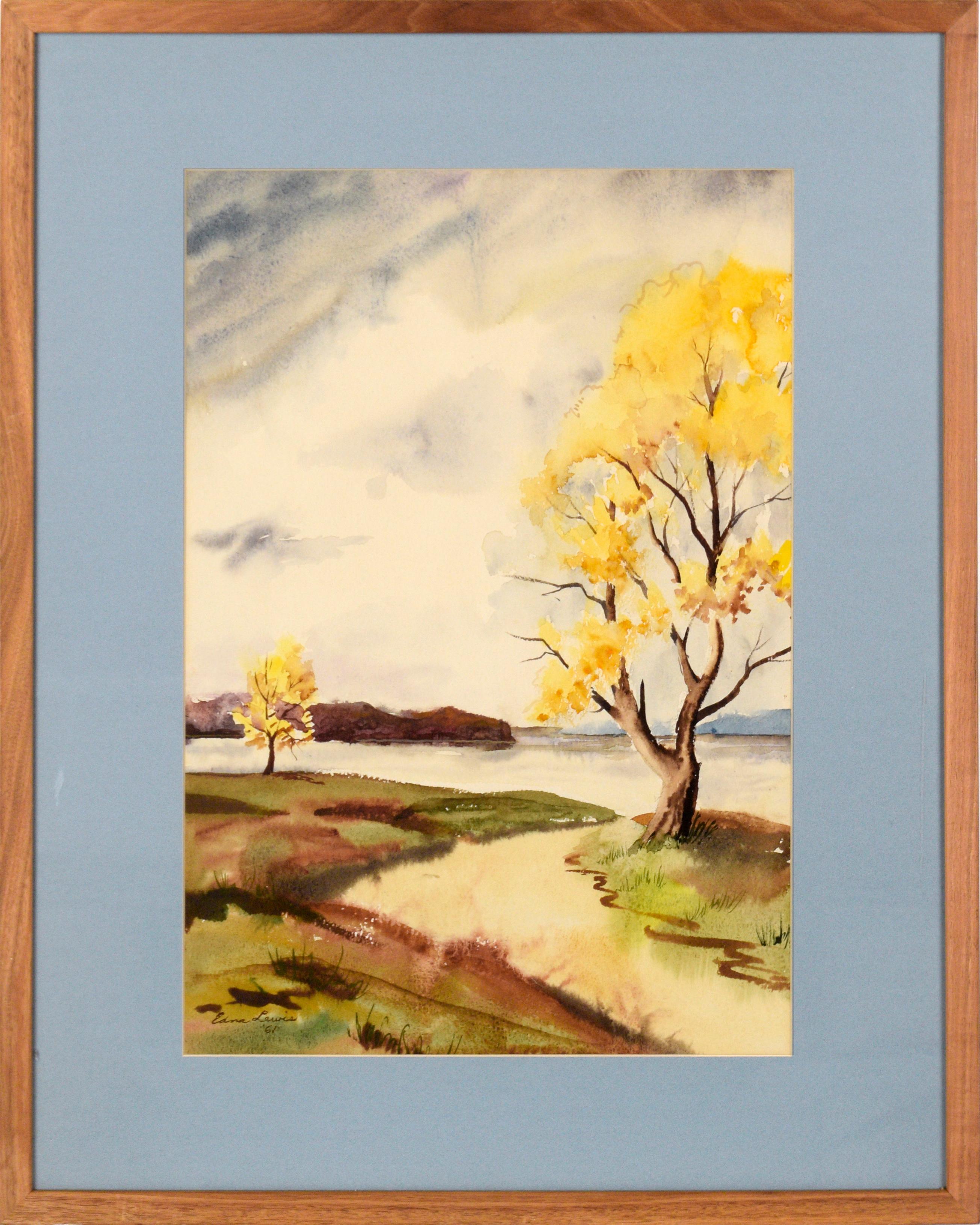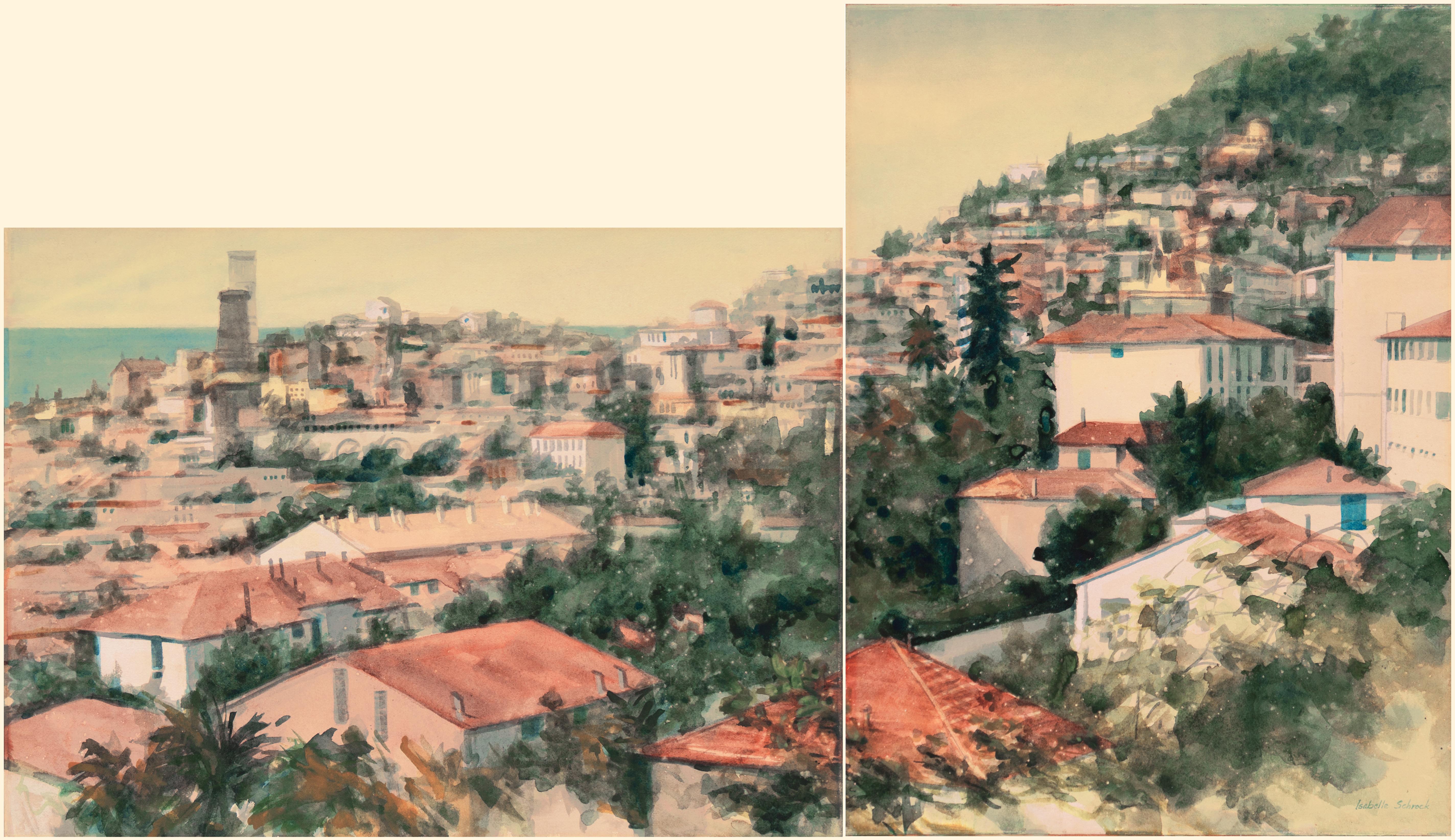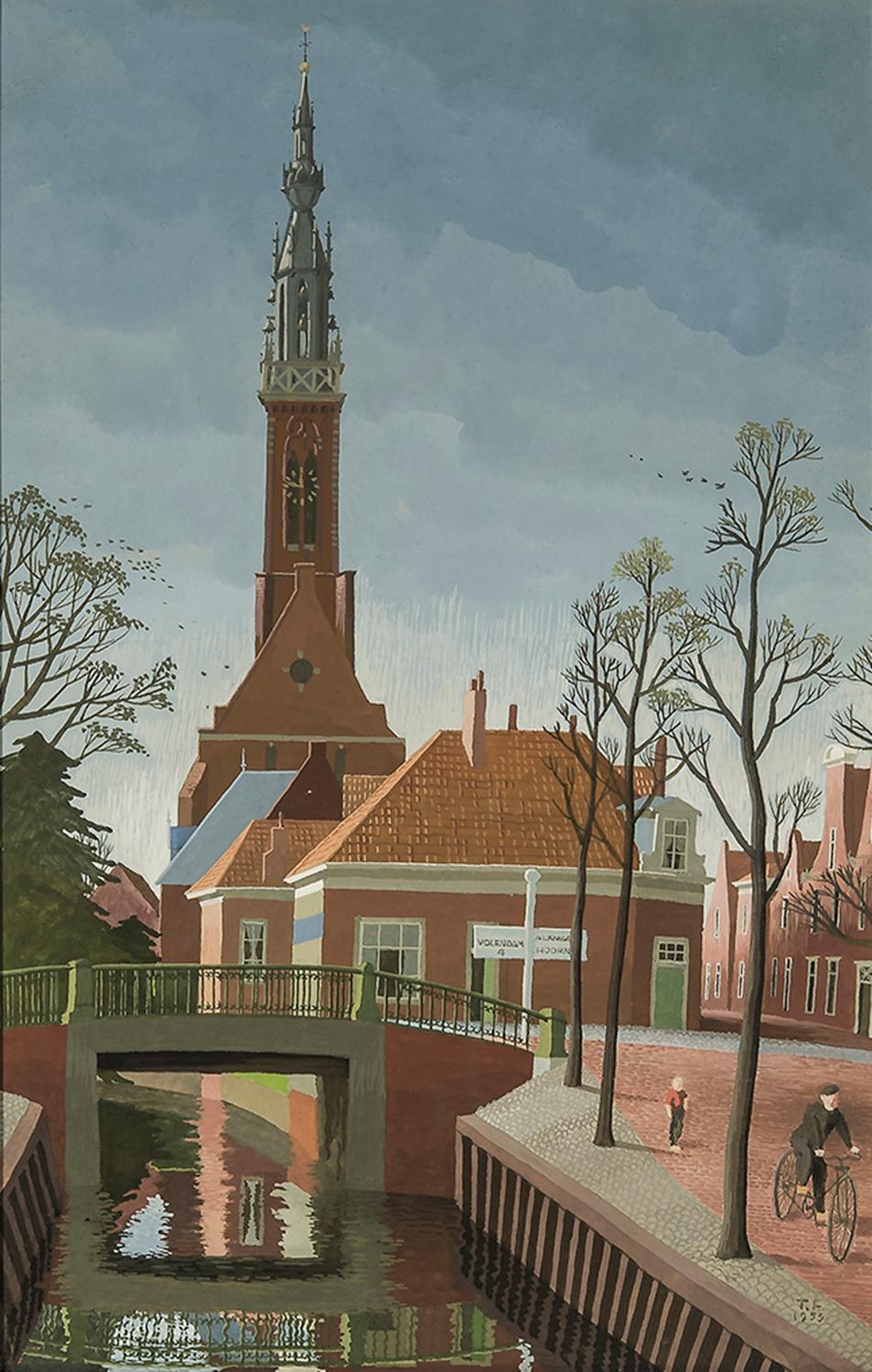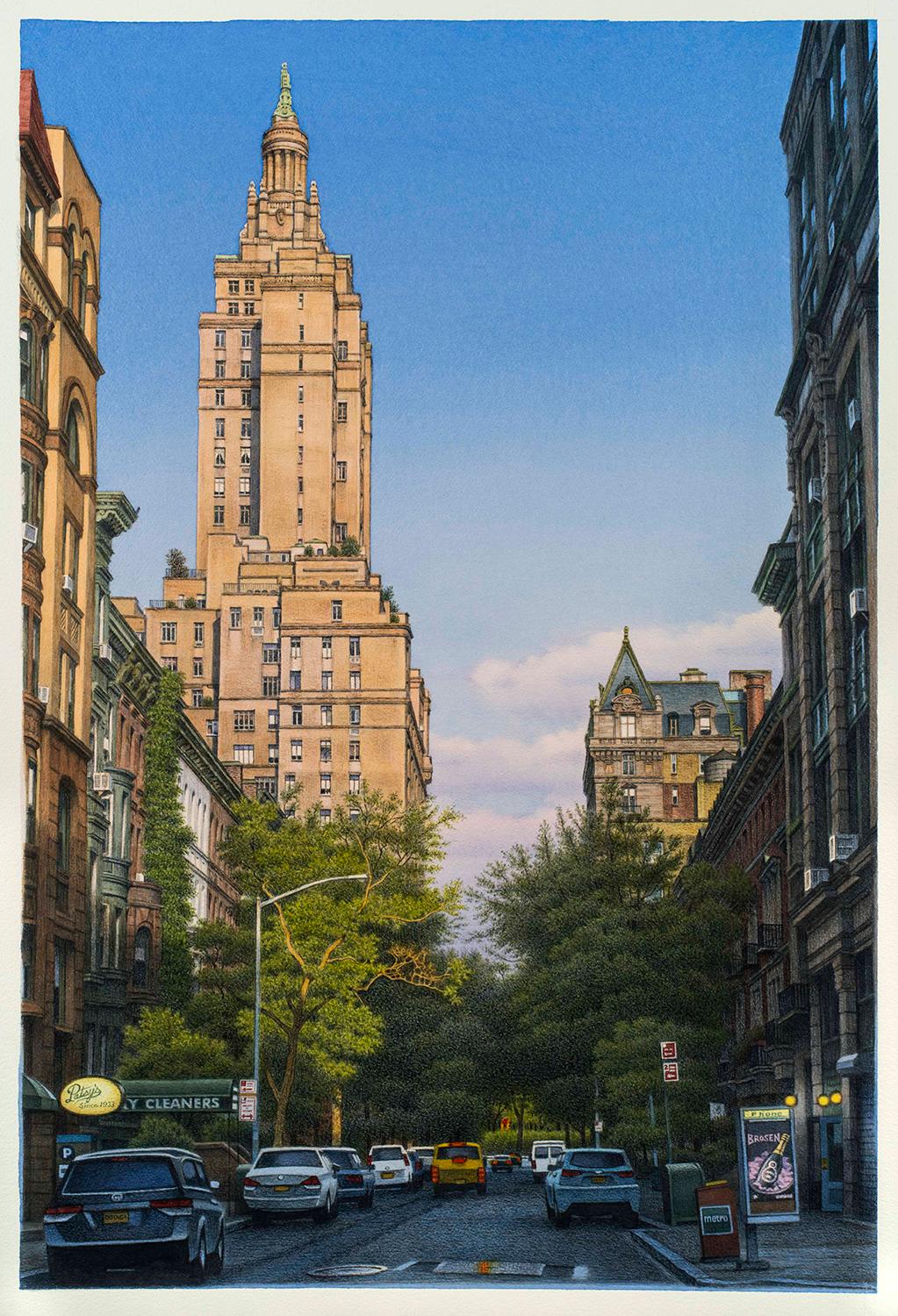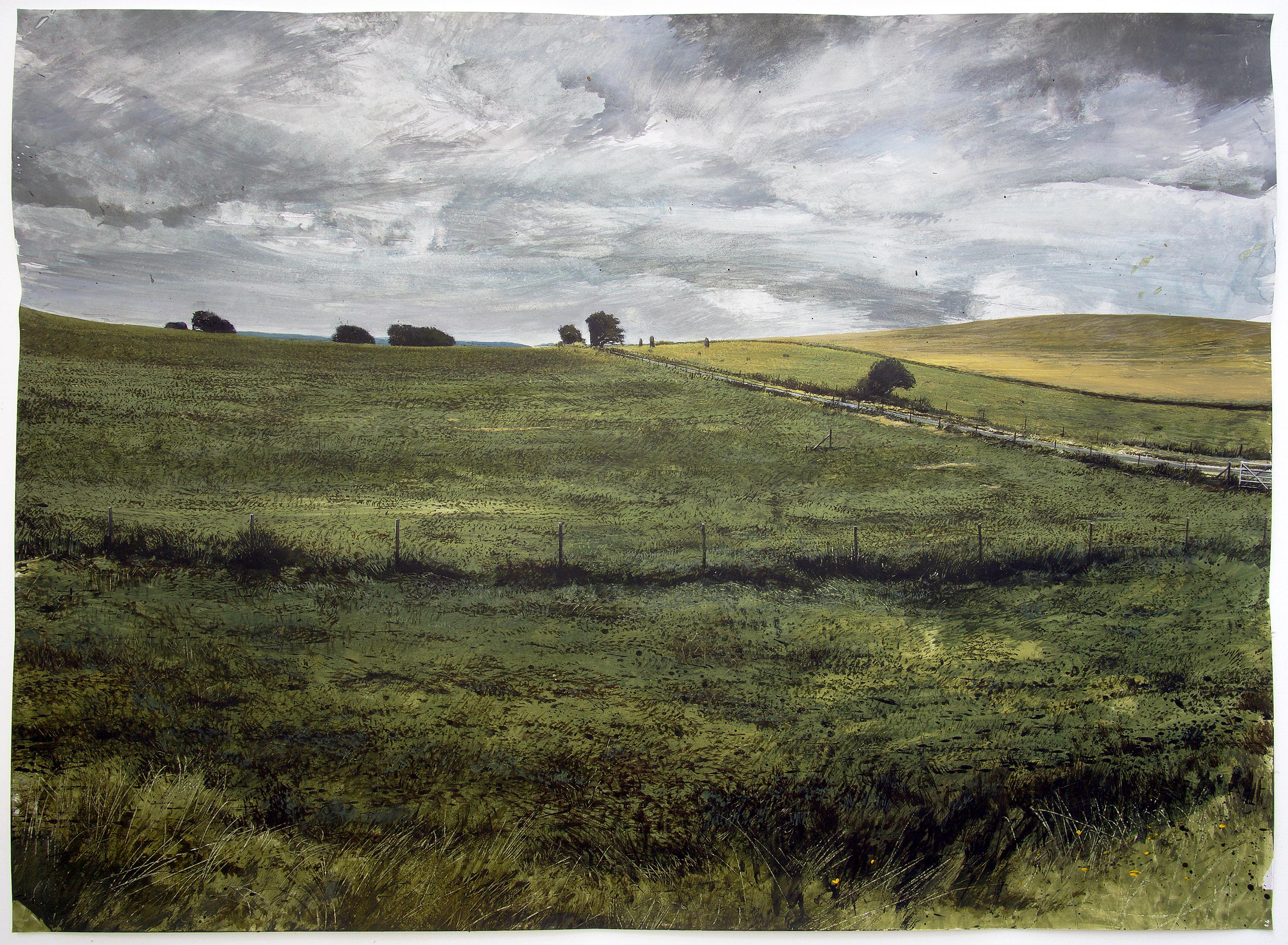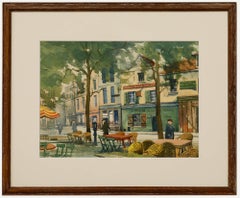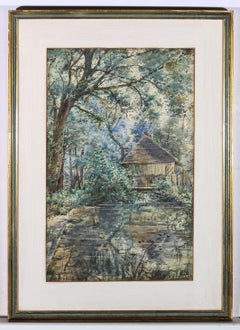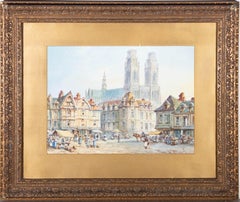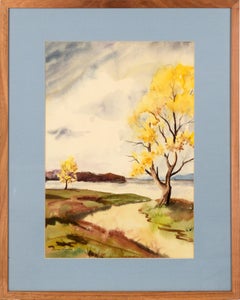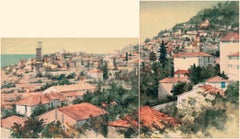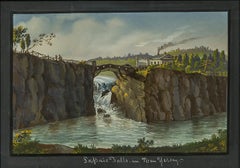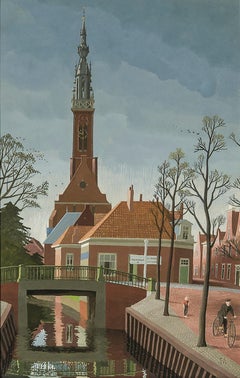Items Similar to John Wilson Hepple (1886-1939) - 1920 Watercolour, Riverscape with Mountains
Want more images or videos?
Request additional images or videos from the seller
1 of 9
John Wilson HeppleJohn Wilson Hepple (1886-1939) - 1920 Watercolour, Riverscape with Mountains1920
1920
About the Item
A fine and delicate watercolour painting by John Wilson Hepple (1886-1939), depicting a rocky river scene with mountains in the distance. Signed and dated within the composition. Elegantly presented in a simple gilt frame and wash-line mount. On watercolour paper.
- Creator:John Wilson Hepple
- Creation Year:1920
- Dimensions:Height: 24.81 in (63 cm)Width: 29.14 in (74 cm)
- Medium:
- Period:
- Condition:The condition is typical for a picture of this age including some discolouration.
- Gallery Location:Corsham, GB
- Reference Number:Seller: rs4861stDibs: LU881312085352
About the Seller
4.9
Platinum Seller
Premium sellers with a 4.7+ rating and 24-hour response times
Established in 2010
1stDibs seller since 2018
1,227 sales on 1stDibs
Typical response time: 5 hours
- ShippingRetrieving quote...Shipping from: Corsham, United Kingdom
- Return Policy
Authenticity Guarantee
In the unlikely event there’s an issue with an item’s authenticity, contact us within 1 year for a full refund. DetailsMoney-Back Guarantee
If your item is not as described, is damaged in transit, or does not arrive, contact us within 7 days for a full refund. Details24-Hour Cancellation
You have a 24-hour grace period in which to reconsider your purchase, with no questions asked.Vetted Professional Sellers
Our world-class sellers must adhere to strict standards for service and quality, maintaining the integrity of our listings.Price-Match Guarantee
If you find that a seller listed the same item for a lower price elsewhere, we’ll match it.Trusted Global Delivery
Our best-in-class carrier network provides specialized shipping options worldwide, including custom delivery.More From This Seller
View AllJohn Weston - Early 20th Century Watercolour, Old Montmartre
Located in Corsham, GB
This watercolour captures the charm of a Parisian street scene in the Parisian district of Montmartre. The artist skillfully renders the narrow, winding street, flanked by traditiona...
Category
20th Century Landscape Drawings and Watercolors
Materials
Watercolor
Jack Cudworth (1930-2010) - 1974 Watercolour, Summer farmland
Located in Corsham, GB
A fine 20th Century watercolour showing farmland and fields in the Summer sun. The artist has signed and dated to the lower right corner and the painting has been presented in a gilt...
Category
Mid-20th Century Landscape Drawings and Watercolors
Materials
Watercolor
$284 Sale Price
20% Off
Mozola - Signed Mid 20th Century Watercolour, Houlgate, France
Located in Corsham, GB
A charming watercolour scene of Le Drochon river flowing through Houlgate, France. We can see a lone house sitting along the river bank and shrouded in trees. The artist has signed t...
Category
Mid-20th Century Landscape Drawings and Watercolors
Materials
Watercolor
$282 Sale Price
20% Off
Pierre Le Boeuff (fl.1899-1920) - Early 20C Watercolour, Orleans, France
Located in Corsham, GB
A charming watercolour painting with gouache details, depicting a view of the Orleans Cathedral in Orleans, France. Signed to the lower right-hand corner. ...
Category
Early 20th Century Landscape Drawings and Watercolors
Materials
Watercolor
Nora Wheeler - Framed Mid 20th Century Watercolour, Fishing Boats at Chioggia
Located in Corsham, GB
A captivating watercolour by British artist Nora Wheeler (b.1892). The scene depicts brightly coloured fishing boats dropping their sails in the seaside town of Chioggia. Wheeler's s...
Category
20th Century Landscape Drawings and Watercolors
Materials
Watercolor
$320 Sale Price
20% Off
Charles G. Davidson RWS (1820-1902) - Framed Watercolour, The Little Windmill
Located in Corsham, GB
This charming composition takes in views of an old working windmill, cottage and cattle, all on the distant horizon. In the foreground a mother and child can be seen approaching a st...
Category
Mid-19th Century Landscape Drawings and Watercolors
Materials
Watercolor
You May Also Like
Lake Landscape with Yellow Trees - Watercolor on Paper
Located in Soquel, CA
Serene watercolor by California artist Edna Lewis (nee Sutherland) (1905-1975). The viewer looks our over an inlet to a lake or bay, with mountain ranges in the distance. Two trees with bright yellow leaves sit at the shore of the water. The sky is rendered with a flowing wet-on-wet style, creating flowing, puffy clouds.
Signed and dated "Edna Lewis 61" in the lower left corner.
Presented in a wood frame with a blue mat.
Frame size: 29"H x 23"W
Paper size: 21.75"H x 15"W
Edna Evelyn Sutherland Lewis (American, 1905-1975) was born in Porterville, CA on April 17, 1905. She studied art at the University of California before going on to study with Kenneth Washburn and Dr. Raymond Brose (San Jose State). Lewis was a long-time resident of Redwood City...
Category
1960s American Impressionist Landscape Drawings and Watercolors
Materials
Watercolor, Laid Paper
$636 Sale Price
20% Off
'California Coastal Diptych', Berkeley, Bay Area Woman Artist, Smithsonian, CCAC
Located in Santa Cruz, CA
Signed lower right, second panel, 'Isabelle Schrock' for Isabelle Schrock Barnett (American, 1903-1995) and painted circa 1975. Additionally signed, verso, on each panel and titled, 'Hillside City' on artist card.
Left panel dimensions: 22 x 30 inches.
Right panel dimensions: 30 x 22 inches.
Total dimensions: 30 x 52 inches.
Exhibited: Lodi 16th Annual Art Exhibition (1975) from partial label, verso, on right panel.
An unusual, asymmetric diptych landscape showing a view of a Northern California coastal city, probably Berkeley, set in gently rolling hills and painted circa 1975.
Born in Augusta, Kansas, Isabelle Schrock Barnett moved to California with her family at the age of five and graduated from the the California College of Arts and Crafts in 1923. She subsequently studied with Frederick Taubes and Yasuo Kuniyoshi. Over the course of a long and successful career as an artist, Isabelle Schrock Barnett exhibited widely and with success including at the Smithsonian Institute in Washington, DC, the Oakland Art Association, the San Francisco League of Women Artists and the Central California Art...
Category
1970s Impressionist Landscape Drawings and Watercolors
Materials
Watercolor, Gouache, Board, Laid Paper, Varnish
Passaic Falls in New Jersey
By Nicolino V. Calyo
Located in New York, NY
Nicolino Calyo's career reflects a restless spirit of enterprise and adventure. Descended in the line of the Viscontes di Calyo of Calabria, the artist was the son of a Neapolitan army officer. (For a brief biographical sketch of the artist see Philadelphia Museum of Art, Pennsylvania, Philadelphia: Three Centuries of American Art, exhib. cat. [1976], pp. 299-301 no. 257.) Calyo received formal training in art at the Naples Academy. His career took shape amidst the backdrop of the political turbulence of early nineteenth-century Italy, Spain, and France. He fled Naples after choosing the losing side in struggles of 1820-21, and, by 1829, was part of a community of Italian exiles in Malta. This was the keynote of a peripatetic life that saw the artist travel through Europe, to America, to Europe again, and back to America.
Paradoxically, Calyo’s stock-in-trade was close observation of people and places, meticulously rendered in the precise topographical tradition of his fellow countrymen, the eighteenth-century
vedute painters Antonio Canale (called Canaletto) and Francesco Guardi. In search of artistic opportunity and in pursuit of a living, Calyo left Malta, and, by 1834, was in Baltimore, Maryland. He advertised his skills in the April 16, 1835 edition of the Baltimore American, offering "remarkable views executed from drawings taken on the spot by himself, . . . in which no pains or any resource of his art has been neglected, to render them accurate in every particular" (as quoted in The Art Gallery and The Gallery of the School of Architecture, University of Maryland, College Park, 350 Years of Art & Architecture in Maryland, exhib. cat. [1984], p. 35). Favoring gouache on paper as his medium, Calyo rendered faithful visual images of familiar locales executed with a degree of skill and polish that was second nature for European academically-trained artists. Indeed, it was the search for this graceful fluency that made American artists eager to travel to Europe and that led American patrons to seek out the works of ambitious newcomers.
On June 16, 1835, the Baltimore Republican reported that Calyo was on his way north to Philadelphia and New York to paint views of those cities. Calyo arrived in New York, by way of Philadelphia, just in time for the great fire of December 1835, which destroyed much of the downtown business district. He sketched the fire as it burned, producing a series of gouaches that combined his sophisticated European painting style with the truth and urgency of on-the-spot observation. Two of his images were given broad currency when William James Bennett reproduced them in aquatint. The New-York Historical Society owns two large Calyo gouaches of the fire, and two others, formerly in the Middendorf Collection, are now in the collection of Hirschl & Adler Galleries. From 1838 until 1855, Calyo listed himself variously in the New York City directories as a painter, a portrait painter, and as an art instructor, singly, and in partnership with his sons, John (1818-1893) and later, the younger Hannibal (1835-1883). Calyo also attracted notice for a series of scenes and characters from the streets of New York, called Cries of New York. These works, which were later published as prints, participate in a time-honored European genre tradition. Calyo’s New York home became a gathering place for European exiles, including Napoleon III. Between 1847 and 1852 Calyo exhibited scenes from the Mexican War and traveled from Boston to New Orleans with his forty-foot panorama of the Connecticut River. Later, he spent time in Spain as court painter to Queen Maria Christina, the result of his continuing European connections, but he was back in America by 1874, where he remained until his death.
The Passaic River rises in the hills just south of Morristown, New Jersey, marking a serpentine eighty-mile course before it empties into Newark Bay. It flows north-northeast to Paterson, where it falls seventy feet in a spectacular cataract before continuing south through Passaic and Newark. William Gerdts, in Painting and Sculpture in New Jersey (1964, pp. 51-2), describes the falls as:
the most important [landscape] subject in New Jersey during the eighteenth and nineteenth centuries. . . . The Passaic Falls remained a popular spot, particularly during the romantic period. Indeed, newspapers, periodicals, and gift books contain many accounts of visits to the Falls, sentimental poems written about them or about a loved one visiting the Falls, or even, occasionally, in memory of one who perished in the waters of the Falls — usually intentionally. . . . Waterfalls . . . were popular among travelers in the period and the Passaic Falls were only surpassed by Niagara Falls and Trenton Falls...
Category
19th Century American Realist Landscape Drawings and Watercolors
Materials
Gouache, Paper
Edam, Holland
By Thomas Fransioli
Located in New York, NY
Thomas Fransioli’s cityscapes are crisp and tidy. Buildings stand in bold outline, their forms squarely defined by stark light and long shadows. Saturated color permeates every corner of his canvases, from vibrant oranges and greens to smoky terra cottas and granites. Even the trees that line Fransioli’s streets, parks, and squares are sharp and angular, exactly like those in an architect’s elevation rendering. But Fransioli’s cities often lack one critical feature: people. His streets are largely deserted, save for parked cars and an occasional black cat scurrying across the pavement. People make rare appearances in Fransioli’s compositions, and never does the entropy of a crowd overwhelm their prevailing sense of order and precision. People are implied in a Fransioli painting, but their physical presence would detract from the scene’s bleak and surreal beauty.
Magic Realism neatly characterizes Fransioli’s artistic viewpoint. The term was first broadly applied to contemporary American art in the 1943 Museum of Modern Art exhibition, American Realists and Magic Realists. As exhibition curator Dorothy Miller noted in her foreword to the catalogue, Magic Realism was a “widespread but not yet generally recognized trend in contemporary American art…. It is limited, in the main, to pictures of sharp focus and precise representation, whether the subject has been observed in the outer world—realism, or contrived by the imagination—magic realism.” In his introductory essay, Lincoln Kirstein took the concept a step further: “Magic realists try to convince us that extraordinary things are possible simply by painting them as if they existed.”
This is Fransioli, in a nutshell. His cityscapes exist in time and space, but certainly not in the manner in which he portrays them.
Fransioli—and other Magic Realists of his time—was also the heir to Precisionism, spawned from Cubism and Futurism after the Great War and popularized in the 1920s and early 1930s. While Fransioli may not have aspired to celebrate the Machine Age, heavy industry, and skyscrapers in the same manner as Charles Sheeler, his compositions tap into the same rigid gridwork of the urban landscape that was first codified by the Precisionists.
During the 1950s, Fransioli was represented by the progressive Margaret Brown...
Category
20th Century American Realist Landscape Drawings and Watercolors
Materials
Gouache, Paper
West 74th Street
By Frederick Brosen
Located in New York, NY
A native New Yorker, Brosen has spent a lifetime wandering its streets, discovering its long history and witnessing its constant metamorphosis. The city is his muse and his primary s...
Category
2010s Contemporary Landscape Drawings and Watercolors
Materials
Watercolor, Paper, Graphite
Untitled (The Road to Swindon)
By Colin Hunt
Located in New York, NY
Colin Hunt (b. 1973) is a Brooklyn, NY-based artist working primarily in egg tempera and watercolor. His recent series of landscapes of the Avebury stone circle outside of London are...
Category
21st Century and Contemporary Photorealist Landscape Drawings and Waterc...
Materials
Watercolor
Recently Viewed
View AllMore Ways To Browse
Mountain Landscape Watercolor
Signed Wilson
A Wilson Painting
Wilson Antique
Rocky Mountain Antique
Riverscape Landscape
Wilson Hepple
Inga Palmgren Drawing
Isabel Wrightson
Isabelle Schrock Barnett
J Kleinschmidt
James Gunnell
Jean Harney
Jess Cauthorn
Joseph Henninger
Joseph Morgan Henninger
Julius Rosenbaum
Lavere Hutchings
